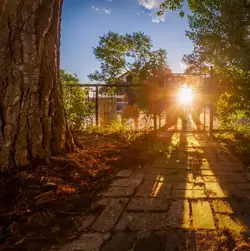Hi Coleman,
I would expose for the sky, and pull up the shadows in post. Or take 3-5 shots, staring at -2 and ending at +2 exposure, and creating a HDR.
I’ve heard of HDR, but I thought people were against it as it creates an artificial effect due to such little contrast. Do most outside photographers use this type of method?
There are ways of achieving shadow and skies in a more exposure, and that’s with graduated neutral density filters. The neutral density filters are made to slow down shutter speeds and they neutralize or reduce the amount of light coming into a filter, thus slower shutter speeds.
With graduated-neutral density filters they’re made with say the upper part of the filter darker to reduce light and from top to about halfway down the filter the filter gradually allows more light through the lens. There are also hard and soft neutral density filters, with the hard ones you have an abrupt change midway down the filter to normal amounts of light passing through the filter causing a line around the middle of the photograph.
It takes good planning, the right type scenes and practice for this type filter. Where as, the soft graduated neutral density filter has a more gradual transition from darker to lighter throughout the filter from top to bottom. This allows a more natural looking composition.
So, you see how this works? Your sky can be exposed at a correct exposure while dialing in your settings to the areas more in shadow to expose them correctly, thus a more correct exposure throughout the photograph.
Another thing to lookout for is there are different densities to each filter, like .06, .09, 1, 1.5, 3, 6, 9, Ext. I don’t know the exact ratios but each either goes up half to one stop to two, maybe 3 stops lighter or darker. Most listings when you go to purchase them tell you how many stops darker the density of the filter is. So, you may want to get more than one filter over time time, or they also have adjustable ones that dial in how much light reduction you want. Now I’m not sure that have that in the graduated filters or not?? Anyone know?
Sent from my iPhone using Tapatalk












![[No title]](/data/xfmg/thumbnail/35/35948-700e0d840da0ca73727b1bd6d99b4142.jpg?1734167751)
![[No title]](/data/xfmg/thumbnail/35/35952-55c8d42ec1c6ff0e13b45356cbf9c068.jpg?1734167758)
![[No title]](/data/xfmg/thumbnail/31/31708-69f4ec98ec000d4fc9a9a1cc282e8e16.jpg?1734160384)